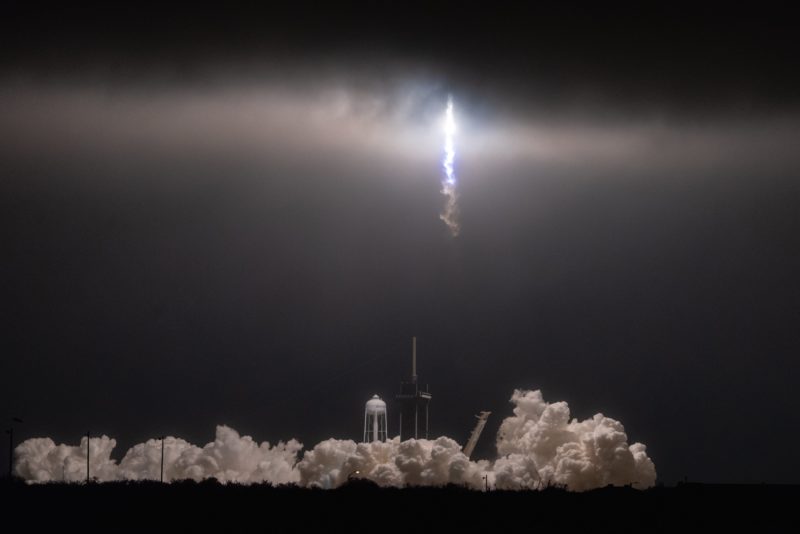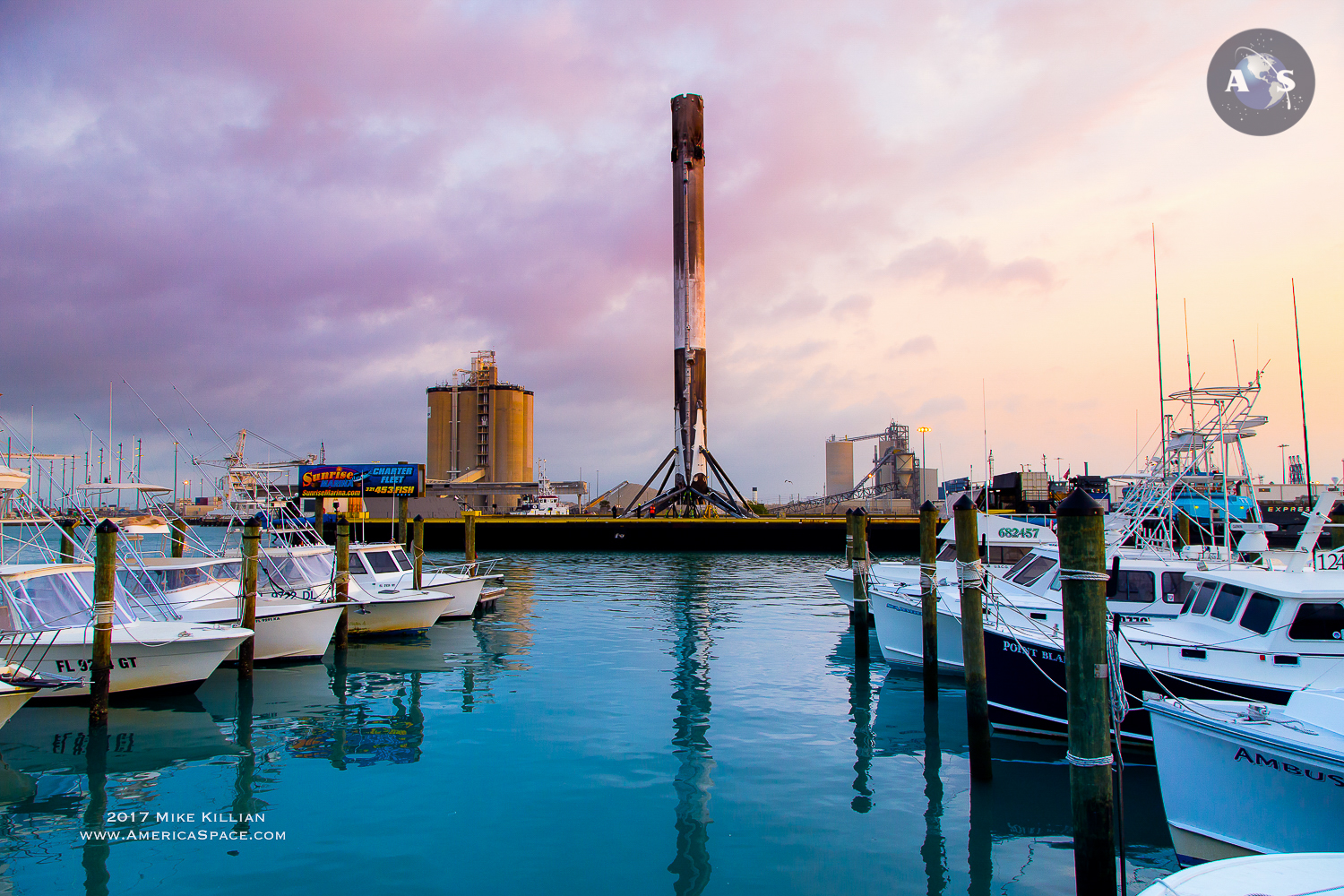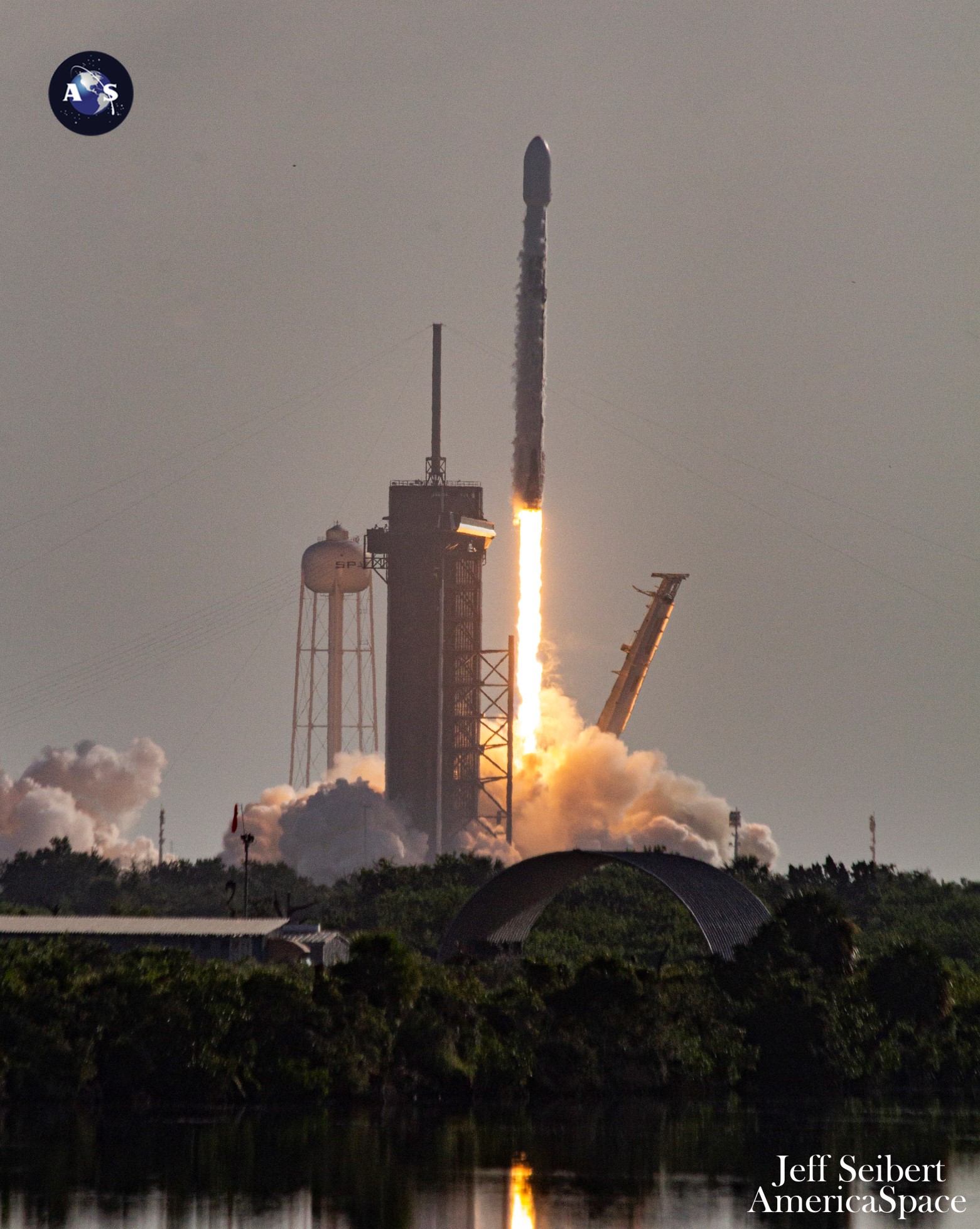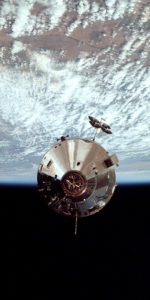
SpaceX has successfully launched its second 8x-flown Falcon 9 booster in a cloudy Thursday morning launch to deliver another 60 Starlink internet communications satellites into low-Earth orbit. Liftoff of the veteran B1049 core—which joins sister B1051 as one of SpaceX’s life-leading boosters—occurred from historic Pad 39A at the Kennedy Space Center (KSC) in Florida at 3:24am EST.
Eight minutes later, with more than a small measure of relief, B1049 returned to a smooth touchdown on the deck of the Autonomous Spaceport Drone Ship (ASDS), “Of Course I Still Love You”, situated about 390 miles (630 km) offshore in the Atlantic Ocean.
Tonight’s recovery marks the resumption of Falcon 9 drone-ship landings, following the untimely loss last month of B1059 at the end of her sixth flight. Having successfully launched from Space Launch Complex (SLC)-40 at Cape Canaveral Space Force Station, Fla., to boost a 60-strong batch of Starlinks on the first leg of their trek up to low-Earth orbit, B1059 began its descent towards the ASDS, hopeful of scoring SpaceX’s 53rd on-point drone ship landing since April 2016. But sadly, it was not to be.
In comments provided Monday during the Crew-2 pre-flight press conference, SpaceX Senior Director of Human Spaceflight Programs Benji Reed furnished a brief summary of the anomaly which took out this “higher-count, flight-proven vehicle” on the night of 15 February. He explained that “some of the components” aboard B1059 “were life-leaders” and the specific issue which doomed B1059 centered upon so-called “boots”, which cover parts of the Merlin 1D+ first-stage engine suite. One of these boots developed a hole, which caused hot-gas intrusion and triggered a premature shutdown of its engine.
The Falcon 9 was designed right from the start with an “engine-out” capability. This allows it to shut down a compromised engine in flight, yet still complete its primary mission. And on the night of 15 February, it did just that and succeeded in its primary objective of getting SpaceX’s 18th operational batch of Starlinks safely to orbit.
However, during its descent to the ASDS—a highly intricate and dynamic maneuver guided by hypersonic grid-fins and deployable landing legs, as well as its Merlins—the engine problem meant that B1059 had insufficient thrust to safely execute a landing. Mr. Reed explained that inspections are underway to understand which life-limiting components require replacement to avoid breaches of the boots and similar engine-out situations in the future.

Aside from its third failed Falcon 9 landing in less than a year, the life-leading booster B1049 has endured its own problems of late. These come on the back of what can only be described as an illustrious 2020, which saw the core fly no less than four times. B1049 first launched way back in September 2018, on a mission which delivered the heavyweight Telstar 18V communications satellite towards Geostationary Transfer Orbit. It went on to lift the final ten-strong batch of Iridium NEXT global mobile communications satellites in January 2019, becoming only the second Falcon 9 core to achieve pinpoint ASDS landings off the East and West Coasts of the United States.
Since then, it flew a record-setting five Starlink missions, delivering 298 of these flat-packed internet communications satellites to space between May 2019 and last November. Notably, these flights saw it become the first Falcon 9 core to return safely from a fifth mission and the first in the fleet to fly a sixth and a seventh time. Including tonight’s eighth foray, B1049 has now touched down six times on the ASDS “Of Course I Still Love You” and twice on “Just Read the Instructions”, including the very first JRTI landing after its relocation from the West Coast to the East Coast last year.
Yet B1049 was pipped to the post in January by her frequent-flying sister B1051 in becoming the very first Falcon 9 to log an eighth launch. The reasons for her longer-than-usual period on the ground remain unclear, with a tight-lipped SpaceX revealing little about the processing timelines of its boosters, but B1049 wound up aiming for her eighth launch at the end of January. Thus began a month-long exercise in frustration, which saw that record-tying launch pushed back no fewer than nine times.

After an exceptionally busy January, with no less than three launches and a hectic plate of duty for both East Coast-based ASDS platforms, the timely return of recovered Falcon 9 cores to port and the turnaround availability of the drone ships made it unlikely that B1049 would fly as planned on the 27th. Indeed, her mission was pushed into the first week of February, but the gremlins of misfortune did not take long to show up. An attempt to static-fire B1049’s nine Merlin 1D+ first-stage engines on the 29th was apparently aborted, although a second attempt took place without incident on the 31st.
Launch was rescheduled for 2 February, but slipped 24 hours to the right on account of projected rough weather in the recovery zone in the Atlantic Ocean. And with expectations that the risk of safely recovering B1049 remained “high” throughout 3 February as well, it came as little surprise when the mission moved again to the more benign conditions expected on the 4th. This pushed it right up against another Starlink flight and for a while 4 February actually looked set to see the launch of two Falcon 9s within 4.5 hours of each other.
As circumstances transpired, in order to allow more time “for pre-launch checks” and the arrival of oceanic recovery assets, B1049’s next flight was pushed back to the 5th, and later the 7th, before SpaceX elected again to stand down for “additional inspections”. Hopes of launching on the 17th came to nothing, following the unsuccessful landing of B1059 a couple of nights earlier, and a second Static Fire Test of B1049 took place on the 24th. This allowed SpaceX to declare its readiness to fly last Sunday.

Sadly, that attempt, too, proved fruitless, when countdown clocks halted dramatically at T-1 minute and 24 seconds, and SpaceX entered a 24-hour recycle for a launch late Monday. That target, too, was moved to the right—initially to Tuesday, then Thursday—to support pre-flight checks, ensure Eastern Range availability and wait for improved launch and recovery weather conditions. Indeed, the weather outlook for Tuesday was predicted to be only 40-percent favorable, according to the 45th Weather Squadron at Patrick Space Force Base, with a risk of showers “and a storm or two” across Central Florida.
Tonight’s launch proceeded without incident, as B1049 smoothly lifted its record-breaking sixth load of Starlinks with pinpoint precision towards low-Earth orbit. All told, this particular booster has lofted 358 Starlinks—30 percent of the total number of these small satellites launched to date—and stands shoulder-to-shoulder with sister B1051 as the joint-most-flown Falcon 9 in SpaceX’s fleet. In addition to her impressive Starlink haul, her inaugural Telstar 18V mission and her Iridium NEXT mission, she has lofted almost 370 primary payloads satisfactorily into orbit.
It remains to be seen when, or indeed, if, B1049 will receive a ninth mission. Her track record thus far has seen her flight-to-flight processing time range from as little as 75 days between two Starlink launches last June and August—to as high as 228 days. Coming up next in about a week’s time from SLC-40 at Cape Canaveral Space Force Station, seasoned veteran B1058 is expected to lift another 60-strong Starlink batch to orbit, as Doug Hurley and Bob Behnken’s old booster launches its sixth mission in a little more than nine months.
.
.
FOLLOW AmericaSpace on Facebook and Twitter!
.
.
Missions » Commercial Space » Starlink »





I’ve just learned that Starlink-17 is critical for the QFS of N.E.S.A.R.A. to operate and function. QFS won’t work without Starlink-17… You learn something new everyday. No, I am not with Space Force. I am just peeking through the clouds.